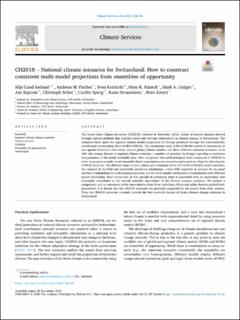Please use this identifier to cite or link to this item:
https://doi.org/10.21256/zhaw-26217Full metadata record
| DC Field | Value | Language |
|---|---|---|
| dc.contributor.author | Sørland, Silje Lund | - |
| dc.contributor.author | Fischer, Andreas M. | - |
| dc.contributor.author | Kotlarski, Sven | - |
| dc.contributor.author | Künsch, Hans R. | - |
| dc.contributor.author | Liniger, Mark A. | - |
| dc.contributor.author | Rajczak, Jan | - |
| dc.contributor.author | Schär, Christoph | - |
| dc.contributor.author | Spirig, Curdin | - |
| dc.contributor.author | Strassmann, Kuno | - |
| dc.contributor.author | Knutti, Reto | - |
| dc.date.accessioned | 2022-11-25T15:34:22Z | - |
| dc.date.available | 2022-11-25T15:34:22Z | - |
| dc.date.issued | 2020 | - |
| dc.identifier.issn | 2405-8807 | de_CH |
| dc.identifier.uri | https://digitalcollection.zhaw.ch/handle/11475/26217 | - |
| dc.description.abstract | The latest Swiss Climate Scenarios (CH2018), released in November 2018, consist of several datasets derived through various methods that provide robust and relevant information on climate change in Switzerland. The scenarios build upon the regional climate model projections for Europe produced through the internationally coordinated downscaling effort EURO-CORDEX. The simulations from EURO-CORDEX consist of simulations at two spatial horizontal resolutions, several global climate models, and three different emission scenarios. Even with this unique dataset of regional climate scenarios, a number of practical challenges regarding a consistent interpretation of the model ensemble arise. Here we present the methodological chain employed in CH2018 in order to generate a multi-model ensemble that is consistent across scenarios and is used as a basis for deriving the CH2018 products. The different steps involve a thorough evaluation of the full EURO-CORDEX model ensemble, the removal of doubtful and potentially erroneous simulations, a time-shift approach to account for an equal number of simulations for each emission scenario, and the multi-model combination of simulations with different spatial resolutions. Each component of this cascade of processing steps is associated with an uncertainty that eventually contributes to the overall scientific uncertainty of the derived scenario products. We present a comparison and an assessment of the uncertainties from these individual effects and relate them to probabilistic projections. It is shown that the CH2018 scenarios are generally supported by the results from other sources. Thus, the CH2018 scenarios currently provide the best available dataset of future climate change estimates in Switzerland. | de_CH |
| dc.language.iso | en | de_CH |
| dc.publisher | Elsevier | de_CH |
| dc.relation.ispartof | Climate Services | de_CH |
| dc.rights | http://creativecommons.org/licenses/by/4.0/ | de_CH |
| dc.subject | Regional climate change scenario | de_CH |
| dc.subject | Climate service | de_CH |
| dc.subject | CORDEX | de_CH |
| dc.subject | Ensemble of opportunity | de_CH |
| dc.subject | Switzerland | de_CH |
| dc.subject.ddc | 363: Umwelt- und Sicherheitsprobleme | de_CH |
| dc.title | CH2018 - National climate scenarios for Switzerland : how to construct consistent multi-model projections from ensembles of opportunity | de_CH |
| dc.type | Beitrag in wissenschaftlicher Zeitschrift | de_CH |
| dcterms.type | Text | de_CH |
| zhaw.departement | School of Engineering | de_CH |
| zhaw.organisationalunit | Zentrum für Aviatik (ZAV) | de_CH |
| dc.identifier.doi | 10.1016/j.cliser.2020.100196 | de_CH |
| dc.identifier.doi | 10.21256/zhaw-26217 | - |
| zhaw.funding.eu | No | de_CH |
| zhaw.issue | 100196 | de_CH |
| zhaw.originated.zhaw | Yes | de_CH |
| zhaw.publication.status | publishedVersion | de_CH |
| zhaw.volume | 20 | de_CH |
| zhaw.publication.review | Peer review (Publikation) | de_CH |
| zhaw.author.additional | No | de_CH |
| zhaw.display.portrait | Yes | de_CH |
| Appears in collections: | Publikationen School of Engineering | |
Files in This Item:
| File | Description | Size | Format | |
|---|---|---|---|---|
| 2020_Sorland-etal_CH2018-national-climate-scenarios-Switzerland_ClimateServices.pdf | 12.4 MB | Adobe PDF |  View/Open |
Show simple item record
Sørland, S. L., Fischer, A. M., Kotlarski, S., Künsch, H. R., Liniger, M. A., Rajczak, J., Schär, C., Spirig, C., Strassmann, K., & Knutti, R. (2020). CH2018 - National climate scenarios for Switzerland : how to construct consistent multi-model projections from ensembles of opportunity. Climate Services, 20(100196). https://doi.org/10.1016/j.cliser.2020.100196
Sørland, S.L. et al. (2020) ‘CH2018 - National climate scenarios for Switzerland : how to construct consistent multi-model projections from ensembles of opportunity’, Climate Services, 20(100196). Available at: https://doi.org/10.1016/j.cliser.2020.100196.
S. L. Sørland et al., “CH2018 - National climate scenarios for Switzerland : how to construct consistent multi-model projections from ensembles of opportunity,” Climate Services, vol. 20, no. 100196, 2020, doi: 10.1016/j.cliser.2020.100196.
SØRLAND, Silje Lund, Andreas M. FISCHER, Sven KOTLARSKI, Hans R. KÜNSCH, Mark A. LINIGER, Jan RAJCZAK, Christoph SCHÄR, Curdin SPIRIG, Kuno STRASSMANN und Reto KNUTTI, 2020. CH2018 - National climate scenarios for Switzerland : how to construct consistent multi-model projections from ensembles of opportunity. Climate Services. 2020. Bd. 20, Nr. 100196. DOI 10.1016/j.cliser.2020.100196
Sørland, Silje Lund, Andreas M. Fischer, Sven Kotlarski, Hans R. Künsch, Mark A. Liniger, Jan Rajczak, Christoph Schär, Curdin Spirig, Kuno Strassmann, and Reto Knutti. 2020. “CH2018 - National Climate Scenarios for Switzerland : How to Construct Consistent Multi-Model Projections from Ensembles of Opportunity.” Climate Services 20 (100196). https://doi.org/10.1016/j.cliser.2020.100196.
Sørland, Silje Lund, et al. “CH2018 - National Climate Scenarios for Switzerland : How to Construct Consistent Multi-Model Projections from Ensembles of Opportunity.” Climate Services, vol. 20, no. 100196, 2020, https://doi.org/10.1016/j.cliser.2020.100196.
Items in DSpace are protected by copyright, with all rights reserved, unless otherwise indicated.